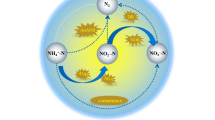Abstract
A chloroaniline-degrading bacterial strain isolated from polluted sediment in the Mekong River was identified as Geobacter sp. KT5. The obtained isolate was found to utilize a wide range of trichloroanilines (TCAs), dichloroanilines (DCAs), monochloroanilines (MACs), and aniline as sources of carbon and energy. It also used Fe(III) as a terminal electron acceptor under anaerobic conditions. Among the chlorinated anilines, KT5 utilized 2,3,4-trichloroaniline (234TCA) with the highest rate (2.48 ± 0.32 µM day−1). On determining the degradation pathway for chloroanilines (CAs) in Geobacter sp. KT5, it showed that the removal of ortho and para halogen was dominant. Firstly, KT5 ortho-dechlorinated some TCAs to DCAs, and then reductively transformed them into MACs and aniline prior to complete degradation with the iron reduction stoichiometry and release of nitrogen and chlorine. The KT5 augmentation in sediment slurry enhanced the degradation of CAs and aniline; however, the anaerobic degradation rates in slurry were significantly lower compared to those in liquid media.







Similar content being viewed by others
Change history
22 March 2019
The original version of this article unfortunately contained a mistake. The authors would like to correct the heading “Anaerobic Biodegradation Intermediates, Enzyme Activities, and the Biodegradation Pathways for CAs” in the Results section. The correct heading should read as “Anaerobic Biodegradation Intermediates and the Biodegradation Pathways for CAs”.
References
Bhatt P, Kumar MS, Mudliar S, Chakrabarti T (2007) Biodegradation of chlorinated compounds—a review. Crit Rev Environ Sci Technol 37:165–198
Boehncke A, Kielhorn J, Konnecker G, Pohlenz-Michel C, Mangelsdorf I (2003) 4-Chloroaniline. Concise International Chemical Assessment Document 48. World Health Organization, Geneva
Bollag JM, Russel S (1976) Aerobic versus anaerobic metabolism of halogenated anilines by a Paracoccus sp. Microb Ecol 3:65–73
Boon N, Goris J, De Vos P, Verstraete W, Top EM (2001) Genetic diversity among 3-chloroaniline- and aniline-degrading strains of the Comamonadaceae. Appl Environ Microbiol 67:1107–1115
Braunschweig J, Bosch J, Heister K, Kuebeck C, Meckenstock RU (2012) Reevaluation of colorimetric iron determination methods commonly used in geomicrobiology. J Mirobiol Methods 89:41–48
Brown JF Jr, Feng H, Bedard DL, Brennan MJ, Carnahan JC, May RJ (1987) Environmental dechlorination of PCBs. Environ Toxicol Chem 6:579–593
Bunce NJ, Merrick RL, Corke CT (1983) Reductive transformations of nitrate with 3,4-dichloroaniline and related compounds by Escherichia coli. J Agric Food Chem 31(5):1071–1075
Duc HD (2016) Biodegradation of 3-chloroaniline by suspended cells and biofilm of Acinetobacter baumannii GFJ1. Appl Biol Chem 59(5):703–709
Duc HD (2017) Degradation of chlorotoluenes by Comamonas testosterone KT5. Appl Biol Chem 60(4):457–465
Ha DD (2018) Anaerobic degradation of 2,4-dichlorophenoxyacetic acid by Thauera sp. DKT Biodegradation 29:499–510
Hongsawat P, Vangnai AS (2011) Biodegradation pathways of chloroanilines by Acinetobacter baylyi strain GFJ2. J Hazard Mater 186:1300–1307
Ismail ZZ, Pavlostathis SG (2010) Influence of sulfate reduction on the microbial dechlorination of pentachloroaniline in a mixed anaerobic culture. Biodegradation 21:43–57
Kuhn EP, Suflita JM (1989) Sequential reductive dehalogenation of chloroanilines by microorganisms from a methanogenic aquifer. Environ Sci Technol 23:848–852
Kuhn EP, Townsend GT, Suflita JM (1990) Effect of sulfate and organic carbon supplements on reductive dehalogenation of chloroanilines in anaerobic aquifer slurries. Appl Environ Microbiol 56:2630–2637
Lacorte S, Perrot MC, Fraisse D, Barcelo D (1999) Determination of chlorobenzidines, in industrial effluent by solid-phase extraction and liquid chromatography with electrochemical and mass spectrometric detection. J Chromatogr A 833:181–194
Loidl M, Ditzelmüller C, Ditzelmüller G, Ferschl A, Streichsbier F (1990) Degradation of aniline and monochlorinated anilines by soil-born Pseudomonas acidovorans strains. Arch Microbiol 155:56–61
Minard RD, Russel S, Bollag JM (1977) Chemical transformation of 4-chloroaniline to a triazene in a bacterial culture medium. J Agric Food Chem 25:841–844
Morrison RT, Boyd RN (1981) Organic chemistry, 3rd edn. Allyn & Bacon, Boston
Piet GJ, Smeenk JGMM (1985) Behavior of organic pollutants in pretreated Rhine water during dune infiltration. In: Ward CH, Giger W, McCarty PL (eds) Ground water quality. Wiley, New York
Reber H, Helm V, Karanth NGK (1979) Comparative studies on the metabolism of aniline and chloroanilines by Pseudomonas multivorans strain An 1. Eur J Appl Microbiol Biotechnol 7:181–189
Schukat B, Janke D, Krebs D, Fritsche W (1983) Cometabolic degradation of 2- and 3-chloroaniline because of glucose metabolism by Rhodococcus sp. An 117. Curr Microbiol 9:81–86
Struijs J, Rogers JE (1989) Reductive dehalogenation of dichloroanilines by anaerobic microorganisms in fresh and dichlorophenol-acclimated pond sediment. Appl Environ Microbiol 55:2527–2531
Susarla S, Yoneza Y, Masunage S (1998) Reductive transformations of halogenated aromatics in anaerobic estuarine sediment: kinetics, products and pathways. Water Res 32(3):639–648
Susarla S, Yonezawa Y, Masunaga S (1997) Reductive dehalogenation of chloroanilines in anaerobic estuarine sediment. Environ Technol 18(1):75–83
Travkin V, Baskunov BP, Golovlev EL, Boersma MG, Boeren S, Vervoort J, van Berkel WJ, Rietjens IM, Golovleva LA (2002) Reductive deamination as a new step in the anaerobic microbial degradation of halogenated anilines. FEMS Microbiol Lett 209:307–312
Yao XF, Khan F, Pandey R, Pandey J, Mourant RG, Guo RKJJH, Russell RJ, Oakeshott JG, Pandey G (2011) Degradation of dichloroaniline isomers by a newly isolated strain Bacillus megaterium IMT21. Microbiology 157:721–726
Zeyer J, Wasserfallen A, Timmis KN (1985) Microbial mineralization of ring-substituted anilines through an ortho-cleavage pathway. Appl Environ Microbiol 50:447–453
Zhang LL, He D, Chen JM, Liu Y (2010) Biodegradation of 2-chloroaniline, 3-chloroaniline, and 4-chloroaniline by a novel strain Delftia tsuruhatensis H1. J Hazard Mater 179:875–882
Zoeteman BCJ, Harmsen K, Linders JBHJ, Morra CFH, Slooff W (1980) Persistent organic pollutants in river water and ground water of the Netherlands. Chemosphere 9:231–249
Acknowledgements
The authors are very thankful to the Center for Chemical Analysis, Dong Thap University, for all their supports and encouragements during their working on this research.
Author information
Authors and Affiliations
Corresponding author
Additional information
Publisher’s Note
Springer Nature remains neutral with regard to jurisdictional claims in published maps and institutional affiliations.
Rights and permissions
About this article
Cite this article
Ha Danh, D., Nguyen Thi, O. Anaerobic Degradation of Chloroanilines by Geobacter sp. KT5. Curr Microbiol 76, 248–257 (2019). https://doi.org/10.1007/s00284-018-1617-7
Received:
Accepted:
Published:
Issue Date:
DOI: https://doi.org/10.1007/s00284-018-1617-7




